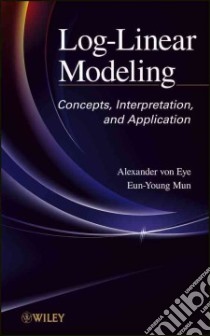Log-linear Modeling - 9781118146408
Un libro in lingua di Eye Alexander Von, Mun Eun young edito da John Wiley & Sons Inc, 2012
- € 102.30
- Il prezzo è variabile in funzione del cambio della valuta d’origine
Over the past ten years, there have been many important advances in log-linear modeling, including the specification of new models, in particular non-standard models, and their relationships to methods such as Rasch modeling. While most literature on the topic is contained in volumes aimed at advanced statisticians, Applied Log-Linear Modeling presents the topic in an accessible style that is customized for applied researchers who utilize log-linear modeling in the social sciences. The book begins by providing readers with a foundation on the basics of log-linear modeling, introducing decomposing effects in cross-tabulations and goodness-of-fit tests. Popular hierarchical log-linear models are illustrated using empirical data examples, and odds ratio analysis is discussed as an interesting method of analysis of cross-tabulations. Next, readers are introduced to the design matrix approach to log-linear modeling, presenting various forms of coding (effects coding, dummy coding, Helmert contrasts etc.) and the characteristics of design matrices. The book goes on to explore non-hierarchical and nonstandard log-linear models, outlining ten nonstandard log-linear models (including nonstandard nested models, models with quantitative factors, logit models, and log-linear Rasch models) as well as special topics and applications. A brief discussion of sampling schemes is also provided along with a selection of useful methods of chi-square decomposition. Additional topics of coverage include models of marginal homogeneity, rater agreement, methods to test hypotheses about differences in associations across subgroup, the relationship between log-linear modeling to logistic regression, and reduced designs. Throughout the book, Computer Applications chapters feature SYSTAT, Lem, and R illustrations of the previous chapter's material, utilizing empirical data examples to demonstrate the relevance of the topics in modern research.
Informazioni bibliografiche
- Titolo del Libro in lingua: Log-linear Modeling
- Sottotitolo: Concepts, Interpretation, and Application
- Lingua: English
- Autori : Eye Alexander Von, Mun Eun young
- Editore: John Wiley & Sons Inc
- Collana: John Wiley & Sons Inc (Hardcover)
- Data di Pubblicazione: 17 Dicembre '12
- Genere: MATHEMATICS
- Argomenti : Log-linear models MATHEMATICS / Probability & Statistics / General. bisacs
- Pagine: 450
- ISBN-10: 1118146409
- EAN-13: 9781118146408


